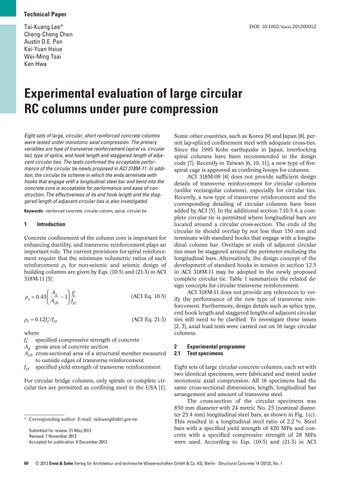Technical Paper Tai-Kuang Lee* Cheng-Cheng Chen Austin D.E. Pan Kai-Yuan Hsiue Wei-Ming Tsai Ken Hwa
DOI: 10.1002/suco.201200012
Experimental evaluation of large circular RC columns under pure compression Eight sets of large, circular, short reinforced concrete columns were tested under monotonic axial compression. The primary variables are type of transverse reinforcement (spiral vs. circular tie), type of splice, end hook length and staggered length of adjacent circular ties. The tests confirmed the acceptable performance of the circular tie newly proposed in ACI 318M-11. In addition, the circular tie scheme in which the ends terminate with hooks that engage with a longitudinal steel bar and bend into the concrete core is acceptable for performance and ease of construction. The effectiveness of its end hook length and the staggered length of adjacent circular ties is also investigated. Keywords: reinforced concrete, circular column, spiral, circular tie
1
Introduction
Concrete confinement of the column core is important for enhancing ductility, and transverse reinforcement plays an important role. The current provisions for spiral reinforcement require that the minimum volumetric ratios of such reinforcement ρs for non-seismic and seismic design of building columns are given by Eqs. (10-5) and (21-3) in ACI 318M-11 [5]: ⎛ A ⎞ f′ ρs = 0.45 ⎜ g − 1⎟ c ⎝ Ach ⎠ fyt
(ACI Eq. 10-5)
ρs = 0.12fc′/fyt
(ACI Eq. 21-3)
where fc′ specified compressive strength of concrete Ag gross area of concrete section Ach cross-sectional area of a structural member measured to outside edges of transverse reinforcement fyt specified yield strength of transverse reinforcement For circular bridge columns, only spirals or complete circular ties are permitted as confining steel in the USA [1].
* Corresponding author: E-mail: taikuang@abri.gov.tw Submitted for review: 21 May 2012 Revised: 7 November 2012 Accepted for publication: 6 December 2012
60
Some other countries, such as Korea [9] and Japan [8], permit lap-spliced confinement steel with adequate cross-ties. Since the 1995 Kobe earthquake in Japan, interlocking spiral columns have been recommended in the design code [7]. Recently in Taiwan [6, 10, 11], a new type of fivespiral cage is approved as confining hoops for columns. ACI 318M-08 [4] does not provide sufficient design details of transverse reinforcement for circular columns (unlike rectangular columns), especially for circular ties. Recently, a new type of transverse reinforcement and the corresponding detailing of circular columns have been added by ACI [5]. In the additional section 7.10.5.4, a complete circular tie is permitted where longitudinal bars are located around a circular cross-section. The ends of the circular tie should overlap by not less than 150 mm and terminate with standard hooks that engage with a longitudinal column bar. Overlaps at ends of adjacent circular ties must be staggered around the perimeter enclosing the longitudinal bars. Alternatively, the design concept of the development of standard hooks in tension in section 12.5 in ACI 318M-11 may be adopted in the newly proposed complete circular tie. Table 1 summarizes the related design concepts for circular transverse reinforcement. ACI 318M-11 does not provide any references to verify the performance of the new type of transverse reinforcement. Furthermore, design details such as splice type, end hook length and staggered lengths of adjacent circular ties still need to be clarified. To investigate these issues [2, 3], axial load tests were carried out on 16 large circular columns.
2 2.1
Experimental programme Test specimens
Eight sets of large circular concrete columns, each set with two identical specimens, were fabricated and tested under monotonic axial compression. All 16 specimens had the same cross-sectional dimensions, length, longitudinal bar arrangement and amount of transverse steel. The cross-section of the circular specimens was 850 mm diameter with 24 metric No. 25 (nominal diameter 25.4 mm) longitudinal steel bars, as shown in Fig. 1(c). This resulted in a longitudinal steel ratio of 2.2 %. Steel bars with a specified yield strength of 420 MPa and concrete with a specified compressive strength of 28 MPa were used. According to Eqs. (10-5) and (21-3) in ACI
© 2013 Ernst & Sohn Verlag für Architektur und technische Wissenschaften GmbH & Co. KG, Berlin · Structural Concrete 14 (2013), No. 1
